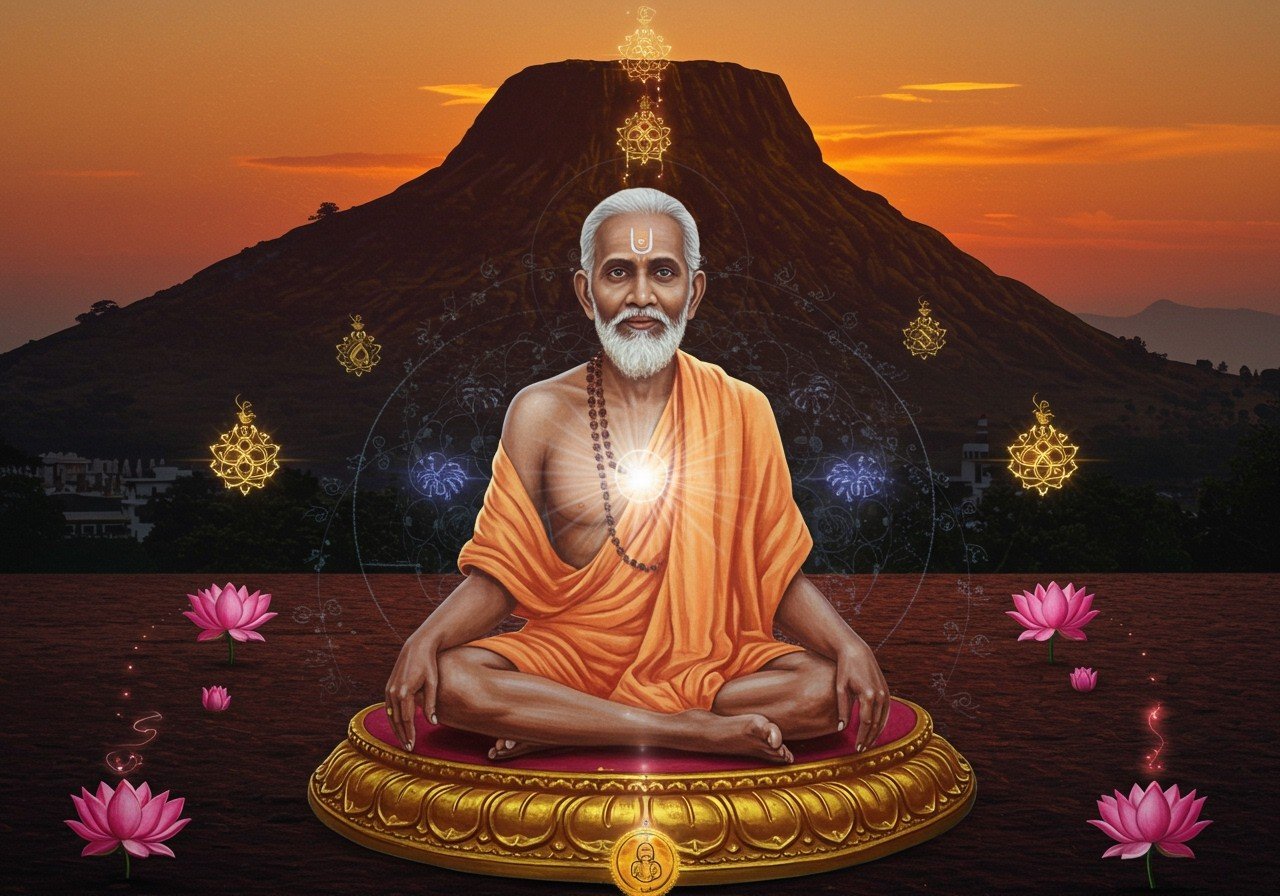
Ramana Maharshi, born Venkataraman Iyer, was a revered Indian Hindu sage and jivanmukta (liberated being). His profound spiritual teachings have guided seekers worldwide on their paths to self-realization. From his humble beginnings in Tiruchuzhi, Tamil Nadu (born December 30, 1879), to his final days in Tiruvannamalai (passed away April 14, 1950), his life exemplifies the power of self-inquiry and the pursuit of inner peace. He encouraged individuals to discover their true selves by asking the simple yet potent question, “Who am I?” His wisdom resonates across spiritual traditions, demonstrating the timeless relevance of his teachings.
Ramana Maharshi’s Unique Approach to Meditation
Ramana Maharshi’s approach to meditation differed from traditional methods. He emphasized self-inquiry, believing that meditation is a tool for turning inwards, enabling individuals to move beyond the limitations of the ego and realize their true selves. The question “Who am I?” serves as a meditative inquiry, leading practitioners to explore deeper levels of consciousness. This focus on non-duality and the dissolution of the mind’s barriers sets his teachings apart. Maharshi believed that once self-realization is attained, meditation becomes a spontaneous and natural expression of one’s being. He didn’t prescribe rigid techniques but emphasized the inner work of self-discovery.
The Profound Silence of Ramana Maharshi
Ramana Maharshi’s teachings went beyond words, highlighting the profound significance of silence, or “mauna“. He didn’t just consider it the absence of speech; for him, it was the stilling of the mind, the cessation of inner chatter. Imagine sharing space with a loved one, understanding each other deeply without uttering a word – that’s the heart of mauna. It’s a state where words become unnecessary, and understanding transcends verbal communication.
Ramana Maharshi often communicated with his disciples through this profound silence. His serene presence spoke volumes, conveying insights without uttering a single word. He believed that within silence resides the ultimate truth, a gateway to divine knowledge and tranquility. When the mind is quiet, he taught, it aligns with the wisdom of the heart, bringing clarity and inner peace.
Stories from his life reveal the role of silence in his interactions. Visitors would approach him with questions, and his response was often a gentle smile or a peaceful gaze. The answers they sought were not given directly but were discovered within themselves, guided by his silent presence. Embracing silence, particularly alongside self-inquiry, can be a transformative practice for those seeking self-realization. It allows for deeper exploration of “Who am I?”, as the mind’s noise fades, revealing the true self.
In our fast-paced world, Ramana Maharshi’s teachings offer a gentle reminder of the power of silence. He invites us to pause, reflect, and connect with our inner selves, fostering a life of harmony and understanding. Perhaps now is a good time to explore resources that can help deepen your spiritual journey. Check out our blog post on the authorship and origins of the Ramayana for a different perspective on self-discovery and ancient wisdom. You might also find this article on the cultural impact of the Ramayana to be a source of inspiration.
Integrating Silence into Daily Life
Ramana Maharshi’s teachings remind us that silence is not merely the absence of sound, but a powerful pathway to understanding and inner peace. In our busy lives, it offers a sanctuary for introspection and connection. By practicing mauna, we honor the wisdom within and discover answers to life’s deeper questions. Begin by incorporating moments of silence into your daily routine. Even a few minutes each morning or before sleep can calm the mind and foster clarity. As you embrace silence, observe how your thoughts settle, creating space for self-discovery. This practice complements self-inquiry, allowing you to explore “Who am I?” with renewed perspective.
Ramana Maharshi’s teachings gently encourage us to value silence as a tool for spiritual growth. By listening to the quiet within, we uncover our inner truth. In this tranquil state, we connect with the wisdom of our hearts and find inner harmony. Allow silence to be your guide on a journey of self-discovery and serenity. If you’re looking to create a peaceful atmosphere for your practice, Poojn.in offers a range of incense and dhoop that can enhance your experience. You can also find Shiva Lingams and other puja items to support your spiritual practices.
Exploring Ramana Maharshi’s Teachings: FAQs
What is the central teaching of Ramana Maharshi? Self-Inquiry, the practice of questioning “Who am I?” to realize one’s true nature beyond the mind and body, forms the core of his teachings. It’s a journey of turning inwards to discover the source of our being.
How did Ramana Maharshi view meditation? He saw meditation as a means to quiet the mind and turn our attention inwards. Unlike traditional techniques, he emphasized the power of self-inquiry as the most direct path to self-realization.
Why did Ramana Maharshi stress the importance of silence? He believed silence, or mauna, is the language of the Self. It allows us to access deeper truths and connect with our essence, going beyond the limitations of words. It creates space for profound inner understanding.
What is the role of destiny according to Ramana Maharshi? He taught that while destiny influences the mind and body, the true Self remains untouched. Through Self-Inquiry, we can transcend the limitations of destiny and realize our inherent freedom.
Is Self-Inquiry accessible to everyone? Yes, Ramana Maharshi’s teachings are open to all who seek self-realization. He encouraged everyone to embark on this journey of self-discovery to find inner peace and self-awareness, regardless of background or experience.
How does Self-Inquiry differ from other spiritual practices? Self-Inquiry focuses directly on the “I,” the sense of self. Unlike practices that involve external rituals or objects of focus, Self-Inquiry turns the mind inward, exploring the very source of our being.
Did Ramana Maharshi recommend any specific posture for Self-Inquiry? No, he didn’t prescribe any particular posture. He emphasized that the true essence of Self-Inquiry lies in the inquiry itself, not the external form. The focus should be on the inner questioning, not the physical position.
Is a guru essential for Self-Inquiry? While a guru can offer guidance, Ramana Maharshi believed that the true guru resides within each of us. Self-Inquiry is a journey of self-discovery, requiring personal effort and deep introspection. Poojn.in offers a curated selection of holy books that can provide further insights into these practices.


